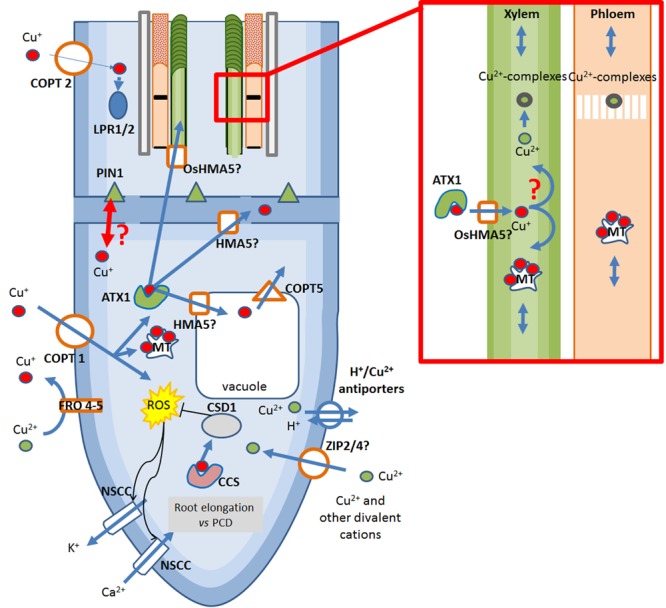FIGURE 2.

Overview of the Cu-transport system occurring at the root tip of dicots. Copper is taken up in the roots in its reduced form Cu+ by COPT proteins, highly selective Cu-transporters. Alternative, but still controversial, Cu uptake system may be non-selective ZIP proteins whereas Cu2+-efflux is mediated by H+/Cu2+ antiporters. In the cytosol, free Cu+ induces the generation of ROS thereby opening NSCCs, allowing the entry of Ca2+ and inducing root growth. Cu may further modulate root growth through interaction with auxin efflux carrier PIN1 and with the multi-copperoxidases LPR1/2. In case excessive Cu enters the roots, the massive generation of ROS activates also the efflux of K+ through NSCC, causing activation of Programmed Cell Death (PCD). ROS can be quenched by the acitivty of CSD1 which acquires Cu from CCS. To prevent ROS generarion, Cu+ is usually chelated by intracellular MTs or specific chaperones ATX1. Cu-transport to extracellular compartments in mediated by HMA5 proteins. In the phloem and in the xylem, Cu in transported in Cu(II)-complexes or Cu(I)-MT complexes. ATX1, antioxidant protein 1; COPT1/2, Cu transporter 1/2; CCS, Cu-chaperones to Cu/Zn superoxide dismutase; CSD1, cytosolic Cu/Zn superoxide dismutase; FRO 4/5, ferric reductase oxidase 4/5; LPR1/2, low phosphate response multi-copperoxidase 1/2; MT, metallothioneins; NSCC, non-selective cationic channels; OsHMA5/AtHMA5, Oryza sativa heavy metal ATPase 5/Arabidopsis thaliana heavy metal ATPase 5; PCD, programmed cell death; PIN1, pin-formed 1; ROS, reactive oxygen species; ZIP, Zrt- and Irt-like protein.
